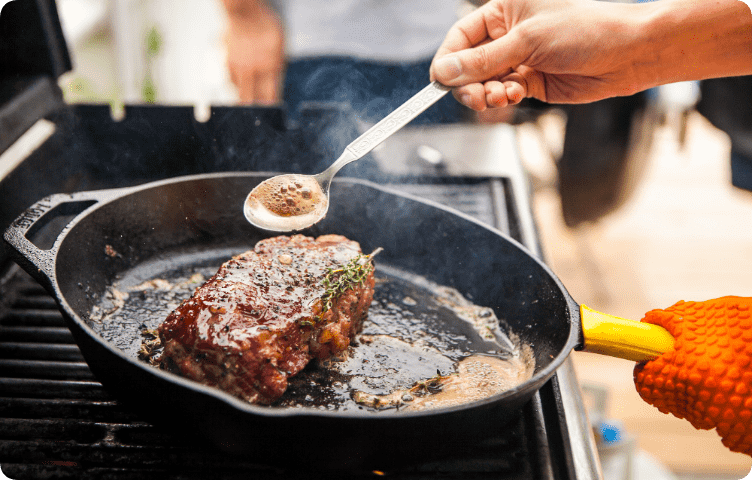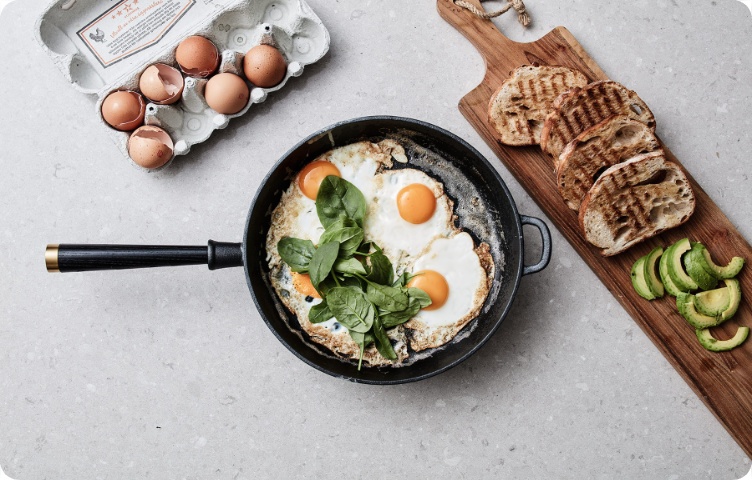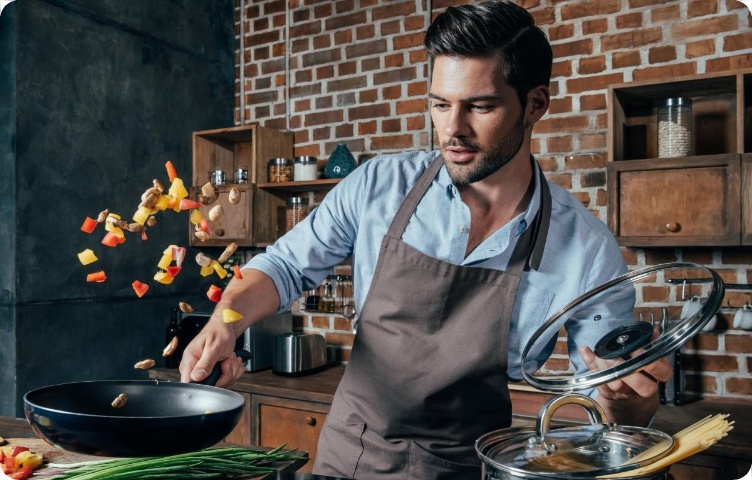Cast iron is one of the best materials for cooking. Cast iron frying pans heat food evenly, retain heat for a long time, and do not burn. It is believed that such utensils require careful care, which worries inexperienced cooks. There is some truth in this, but cast iron cookware has many more advantages.
Pros and cons of cast iron frying pans
The alloy of iron and carbon has been used to make kitchen equipment for 2,500 years. Products made from this material are incredibly durable. There are many stories about frying pans that were passed down in one family from generation to generation, and were even mentioned in wills as family property.
In addition to durability, cast iron attracts cooks with its excellent heat-insulating properties. It heats up slowly but distributes heat evenly. Food in such dishes retains its natural juiciness and aroma.
Good cast iron utensils do not corrode . If a rusty coating appears on the surface, it can be easily removed. Caring for the product is unique, but not difficult - before first use, the frying pan needs to be greased with oil and heated over a fire. Thanks to this, a natural non-stick layer is formed on the walls. Moreover, the cost of cast iron cookware is much lower than Teflon cookware.
Fans of cast iron appreciate the fact that their food is not contaminated with chemicals and carcinogens, as when using utensils made from other metals.
The disadvantages of cast iron utensils include:
- heavy weight;
- strong heating of the handle;
- incompatibility with acidic foods;
- the need for regular oil lubrication;
- risk of damaging the surface of the slab.
The disadvantages are compensated by the versatility of application. You can cook any type of food in a cast iron skillet, including meats, vegetables, crispy potatoes and baked goods. The product is suitable for various culinary operations - baking in the oven, slow simmering, frying on the stove and fire.

Types of cast iron frying pans
The classic model of the product is equipped with a deep container with a thick bottom and a handle. There are options with two handles, a container divided into compartments, and a corrugated bottom. But cast iron frying pans are usually classified according to the type of coating.
For induction cookers
Hobs operating on the principle of electromagnetic induction interact only with special cookware. It should contain a lot of ferromagnetic metal. Most cast iron utensils meet this requirement. To check whether a frying pan is suitable for an induction cooker, simply hold a piece of magnet to the bottom. If it sticks, the product is compatible with the stove.
Another condition is that the diameter of the bottom matches the size of the burner. It is important that the thickness of the base is 5-10 mm. A thinner plane may become deformed due to heating.

Without cover
Pure cast iron is an environmentally friendly material with high thermal conductivity. Utensils made from it allow you to cook food on a gas and electric stove, induction panel, wood-burning oven, barbecue, fire and hot coals. During the cooking process, food is naturally enriched with iron, which is beneficial for health.
Contact with moisture leads to the formation of rust on the surface of the utensil. This is why a pure cast iron frying pan must be wiped dry after washing. From time to time, the walls of the product must be treated with “seasoning” - vegetable oil, and then calcined in the oven. Modern manufacturers carry out this treatment at the factory, but subsequently the owners must repeat the procedure themselves. Thanks to this, uncoated cookware acquires non-stick properties.
Pure cast iron does not tolerate sudden temperature changes. It is not recommended to fill a hot frying pan with cold water - the product may crack. Even cooled dishes cannot be placed in the refrigerator, as the metal oxidizes due to condensation. Uncoated utensils are not suitable for storing prepared dishes - the food in them takes on an unsightly dark tint.
Non-stick coating
The surface of cast iron is dotted with microscopic pores, which gradually absorb food odors. This property can deteriorate the quality of prepared dishes. A protective coating that also has non-stick properties helps correct this drawback. Manufacturers use ceramic coating or non-stick coating. The first type involves applying ceramic enamel to the inner surface of the frying pan. This technology protects the product from the formation of rust and cracks, and increases non-stick properties. There are models finished with ceramic compositionavom inside and out. They are microwave safe and do not oxidize, but will degrade the taste of food if left in the bowl overnight. Ceramic coating has two drawbacks - a short service life (2 years) and the inability to fry food until crisp.
Cast iron utensils can be coated with non-stick coating - a thin layer of Teflon. The coating eliminates the need to regularly lubricate and calcinate the product. The Teflon layer prevents corrosion and absorption of foreign odors. But after 2-3 years the coating becomes thinner and loses its properties.

With enamel treatment
Another common type of coating is heat-resistant enamel. It gives cast iron cookware a smooth finish and protects against rust. You can store ready-made dishes in it, including those made from foods rich in acids. The enamel is easy to clean, both by hand and in the dishwasher.
The only drawback of the enamel coating is its short service life. Scratches on the surface quickly lead to destruction of the enamel layer. Therefore, enameled products cannot be scraped with metal kitchen utensils or washed with abrasive sponges.
How to choose?
If you have never used a cast iron frying pan before, think about what kind of dishes you are going to cook with it? A product made of pure cast iron has a rough surface, so it is not suitable for frying fish and seafood. For delicate protein products, dishes with an enamel coating are more suitable. It is more convenient to cook baked goods in containers with a thin bottom; for meat, on the contrary, a massive base is required.
Consider four more characteristics:
size - most often stores offer dishes with a bottom diameter of 20 cm. For a large family, a product with a diameter of 25-35 cm is recommended;
weight - check in advance whether it will be convenient to lift a heavy frying pan from the stove. Please note that after adding ingredients it will become even heavier, which will complicate the cooking process. It is difficult to find a suitable storage place for utensils that are too heavy;
handle - choose a product with a long, comfortable handle that helps you maneuver the hot, heavy pan. An additional advantage is the second handle on the opposite side. Please note that the metal gets very hot, so it is better to look for a model with a handle coated with silicone;
additional details - a spout or sides will be a good help during cooking. They allow you to drain excess liquid formed when frying meat or stewing vegetables.
The cost of a cast iron frying pan starts from 800 rubles. A high price usually means that the product is lightweight and has a smooth surface.

You can give a professional cook an antique cast iron frying pan. It is known that antique products are lightweight and have a thin bottom, so they are more convenient to use. The surface of antique cast iron is less lumpy, which means its non-stick properties are higher. When choosing vintage utensils, make sure that they do not have deep scratches, dents or ingrained rust.
Preparation for use
If you have a new cast iron product for frying and baking, you need to carry out preparatory measures before using it. Oiling cast iron is the process of creating a thin layer of oil over the entire surface (both interior and exterior) of the pan, and then baking it to form a natural non-stick coating.
To do this, follow these steps:
- Preheat the oven to 180°C.
- Wash the container and lid thoroughly, both inside and out, using a stiff brush.
- After washing, rinse and dry the dishes completely.
- Apply melted shortening or vegetable oil evenly to the entire surface of the cast iron cookware, including the handle and outside sides. Use a spray bottle if possible.
- Place cast iron pan on bottom rack of oven, lined with aluminum foil to catch drippings and prevent oven contamination. Place the lid inside the oven with the bottom up.
- Bake the dish and lid in the oven for one hour at the specified temperature.
- After this, turn off the oven and leave the cast iron cookware in it until it cools completely.
- Once the process is complete, your cookware will turn brown and will be ready to use.
- If you want to repeat the procedure, this will only improve the properties of the cookware. The brown color will become more saturated, improving the appearance.
How to care?
Cast iron frying pans are washed immediately after use, without leaving food or liquid residues inside for a long time. SchiIt appears that detergents should not be used. But if the dishes are very greasy, add a little mild soap to the water. It breaks down fats without disturbing the protective layer. Another good way to wash cast iron is with hot water and fine salt.
Sticky food residues that cannot be removed with a sponge can be scraped off with a wooden or nylon spatula. Abrasive agents are unacceptable - they remove the “seasoning”.
After washing, dry the dishes thoroughly with a paper towel and apply a thin layer of vegetable oil to the inner and outer surfaces. To dry the dishes perfectly, place them on low heat and keep them there for 5 minutes until the water has completely evaporated. Then wipe it again and put it in storage.
From time to time, cast iron utensils need to be “seasoned” - to create a protective fat layer on the surface.
Here's how to do it correctly:
- Wash the product with warm water and soap and a sponge, and if it is very dirty, use a stiff brush.
- Dry the surface with a soft cloth or paper towel.
- Pour 1-2 tablespoons of vegetable oil or shortening into the pan. You can use sunflower or flaxseed oil. Spread it with a clean cloth over the bottom and sides, then lubricate the outside of the dish.
- Place the pan upside down on the center rack of the oven. Place a sheet of aluminum foil on the bottom baking sheet to catch any oil drippings.
- Warm up for an hour at +180°C.
- Turn off the heat and let the pan cool completely without removing it from the oven.
After this treatment, the frying pan becomes smooth and shiny, and a non-stick layer is formed on the surface. It needs to be renewed when the dishes become dull and food begins to stick to the bottom during cooking.
To ensure that cast iron utensils retain their properties longer, do not leave them on the fire or in the oven for a long time. Excessive heat causes the metal to crack.
















































/https%3A%2F%2Fcomplexbar.com%2Fimages%2Fblog%2F58%2Fchugunnye-skovorodki.jpg)
/https%3A%2F%2Fcomplexbar.com%2Fimages%2Fblog%2F245%2Fskov_glavn.jpeg)
/https%3A%2F%2Fcomplexbar.com%2Fimages%2Fblog%2F245%2Fhaiboli.jpg)
/https%3A%2F%2Fcomplexbar.com%2Fimages%2Fblog%2F245%2Fvilki-na-stole-752x480.jpeg)
/https%3A%2F%2Fcomplexbar.com%2Fimages%2Fblog%2F246%2F2024-04-09_17.22.54.jpg)
/https%3A%2F%2Fcomplexbar.com%2Fimages%2Fblog%2F246%2F2024-04-09_17.22.47.jpg)
/https%3A%2F%2Fcomplexbar.com%2Fimages%2Fblog%2F246%2FCODE_anons_foamydrops_752%D1%85480_eng.jpg)
/https%3A%2F%2Fcomplexbar.com%2Fimages%2Fblog%2F246%2FAlina_752%D1%85480_eng.jpg)
/https%3A%2F%2Fcomplexbar.com%2Fimages%2Fblog%2F246%2F2024-04-09_17.23.22.jpg)
/https%3A%2F%2Fcomplexbar.com%2Fimages%2Fblog%2F246%2F2024-04-09_17.23.28.jpg)
/https%3A%2F%2Fcomplexbar.com%2Fimages%2Fblog%2F246%2F2024-04-09_17.23.35.jpg)
/https%3A%2F%2Fcomplexbar.com%2Fimages%2Fblog%2F246%2Fdrinksome_752%D1%85480_eng.jpg)
/https%3A%2F%2Fcomplexbar.com%2Fimages%2Fblog%2F246%2Fnude_752%D1%85480_eng.jpg)
/https%3A%2F%2Fcomplexbar.com%2Fimages%2Fblog%2F246%2F752%D1%85480_eng__1_.jpg)
/https%3A%2F%2Fcomplexbar.com%2Fimages%2Fblog%2F246%2F752%D1%85480_eng.jpg)
/https%3A%2F%2Fcomplexbar.com%2Fimages%2Fblog%2F246%2FStudioRaw_752%D1%85480_eng.jpg)
/https%3A%2F%2Fcomplexbar.com%2Fimages%2Fblog%2F246%2FDoppio_tea_752%D1%85480_eng.jpg)
/https%3A%2F%2Fcomplexbar.com%2Fimages%2Fblog%2F246%2FTognana_Stars_Stripes_752%D1%85480_eng.jpg)
/https%3A%2F%2Fcomplexbar.com%2Fimages%2Fblog%2F246%2FRona_752%D1%85480_eng.jpg)
/https%3A%2F%2Fcomplexbar.com%2Fimages%2Fblog%2F246%2FDoppio_vending_752%D1%85480_eng.jpg)
/https%3A%2F%2Fcomplexbar.com%2Fimages%2Fblog%2F246%2FEssence_sukhie_smesi_752%D1%85480_eng.jpg)
/https%3A%2F%2Fcomplexbar.com%2Fimages%2Fblog%2F246%2FODK_sukhie_smesi752%D1%85480_eng.jpg)
/https%3A%2F%2Fcomplexbar.com%2Fimages%2Fblog%2F246%2Funiforma-barmena.jpg)
/https%3A%2F%2Fcomplexbar.com%2Fimages%2Fblog%2F246%2Fkak-nanyat-barmena.jpg)
/https%3A%2F%2Fcomplexbar.com%2Fimages%2Fblog%2F246%2Fsirop_scale_2400.jpeg)
/https%3A%2F%2Fcomplexbar.com%2Fimages%2Fblog%2F246%2FPeugeot_Anons_Paris_U%27Select_Line_Daman_752%D1%85480_eng.jpg)
/https%3A%2F%2Fcomplexbar.com%2Fimages%2Fblog%2F246%2Fkofe-vostochniy.jpg)
/https%3A%2F%2Fcomplexbar.com%2Fimages%2Fblog%2F246%2FMadler.jpg)
/https%3A%2F%2Fcomplexbar.com%2Fimages%2Fblog%2F246%2Fprofbartender_glavn.jpeg)